ARRIVE PARO & TRANSFER TO THIMPHU - (55 KM/approx 1:30 hr drive)
The flight to Paro is one of the most spectacular in entire Himalayas. Flying along the Himalayan range from Kathmandu, the journey offers fascinating views and an exciting descent into the Kingdom. Bhutan’s first gift to you as you disembark from the aircraft will be cool, clean fresh mountain air.
On arrival at Paro airport, you will be received by our representative with a “tashi khaddar” (white scarf offering to the guest which is an auspicious way to welcome guest) and transfer to Thimphu, the modern capital town of Bhutan.
On arrival, in Thimphu check-into the hotel. The capital town of Bhutan and the centre of government, religion and commerce, Thimphu is a unique city with unusual mixture of modern development alongside ancient traditions. With the population of about 90,000 it is perhaps still the world’s only capital city without a traffic light.
Later in the day take an exploratory walk around local market place located a few minutes’ walk from hotels. Or take a walk to local craft Bazar recently established under patronage of Department of cottage & small industry and in collaboration with the department of culture, tourism council and the department of agriculture marketing and cooperatives, this market offers genuine Bhutanese arts & crafts thus contributing in promotion, protection and preservation of traditional arts.
(unlike other typical Asian tourist marketplace, this is a unique place where you will not find pesky shopkeeper or hawker coxing you to buy their artefacts, you can wander around in peace admiring the craftsmanship and uniqueness of the Bhutanese local market)
Overnight at the hotel in Thimphu (altitude 2,320m)



CLOSING DAYS OF SOME OF MONUMENTS MENTIONED IN ITINERARY:
- Ta Dzong – Paro (national museum) : closed on Government Holidays
- National Library – Thimphu : closed on Sat, Sun & on Government Holidays
- Textile Musuem – Thimphu : Closed on Government Holidays & on Sun. On Sat open from 9.00 a.m to 4 p.m
- Institute of Zorig Chusum (Arts & Crafts School) - Thimphu : Closed on Sun & Government Holidays. On Sat open from 10 a.m to 12 o’clock. Also closed in winter/summer (Dec-early March, June-Aug – closing date available only a few weeks before).
- Simply Bhutan – Thimphu : Closed on Sun & on Government Holidays
- Taktsang Monastery (Tiger’s Nest) – Paro : to be advised
(this is currently available closing/opening information and is subject to change as per the Govt policy)
IN AND AROUND THIMPHU VALLEY
After breakfast at hotel, drive to visit 16th century Pangri Zampa. It is the oldest monastery in Bhutan, located just north of Thimphu. There is now a monastic school where Buddhist students monks learn Lamaism and astrology based on Buddhist philosophy. You can interact with monks there with the help of your guide (monks do not speak other language other than Dzongkha).
** Here you can also have your astrology read by professional monk based on Buddhist principle (donate directly as per clients wish)
Later in the afternoon sightseeing in Thimphu valley with visit of the Simply Bhutan Museum: The newly commissioned museum depicts the ancient Bhutanese architecture which is being lost to modernization. The uniqueness of the structure is in its composition of the materials used. The structure is built reusing old timber, window and door frames and other items from traditional and old demolished houses. The best part is the portrayal of the age-old life styles of the Bhutanese people.
(you can also try a free archery using traditional bows and arrows here at a mini archery ground. This is very interactive place where you can learn a lot about traditional and cultural life, you can also rent traditional dress for a photoshoot for a small fee of USD 2)
Drive to post office where you have Bhutanese stamp made on your name – you can official use these stamps ** Supplement applies
Visit Institute for Zorig Chusum: Commonly known as Arts & Crafts School or Painting School, the Institute offers a six-year course on the 13 traditional arts and crafts of Bhutan. On a visit, one can see students learning the various skills taught at the school.
Continue drive on to Buddha Point (Kuensel Phodrang): Located at a short drive from Thimphu city centre, visitors can get a good overview of the Thimphu valley from the Buddha point (Kuensel Phodrang). You can pay your obeisance and offer prayers to the Buddha, the largest statue in the country and then walk around and take a glimpse of the valley.
Later in the day visit Trashichhoedzong, “fortress of the glorious religion”. This is the center of government and religion, site of monarch’s throne room and seat of Je Khenpo or Chief Abbot. Built in 1641 by the political and religious unifier of Bhutan, Shabdrung Ngawang Namgyal, it was reconstructed in 1960s in traditional Bhutanese manner, without nails or architectural plans.
Overnight at the hotel in Thimphu.

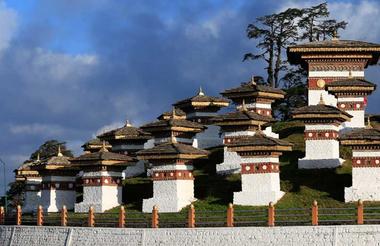
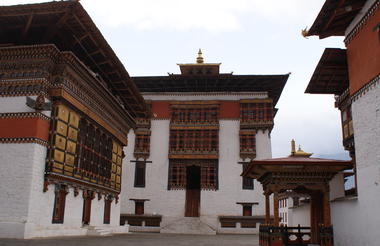
THIMPHU - GANGTEY (150 KMS, APPROX 5:30-6:30 HRS DRIVE)
After breakfast, enjoy a dramatic drive over the high mountain pass of Dochu La (3,O8Om) to Gangtey (Phobjikha) passing through dense forests and oak, rhododendron tress.
The journey continues over the 3,050m mountain pass where on a clear day, the towering Himalayan peaks are clearly visible. The highway follows the scenic Dang Chhu before climbing through forests of bamboo and oak. Stop briefly at Dochu la to take in the grand vista of eastern Himalayan Range.
On arrival at Gangtey (Phobjikha), check-in into hotel.
The valley of Gangtey is one of the most beautiful spots in Bhutan. The surprise of finding such a wide, flat valley without any trees after the hard climb through dense forests is augmented by an impression of vast space, and extremely rare experience in Bhutan where most of the valley’s are tightly enclosed. A few kilometers beyond the Gangtey Monastery, on the valley floor lies the village of Phobjikha. This place is the winter home of black necked cranes that migrate from the arid plains in the north to pass winter in milder and lower climate. Phobjikha, at an altitude of 2900 m, falls under the district of Wangduephodrang and lies on the periphery of the Black Mountain National Park.
Lunch at hotel.
Later visit Gangtey Gompa, perched on a small hill that rises from the valley floor, the Gangtey Monastery is the only Nyingmapa monastery on the western side of the Black Mountain’s and also the biggest Nyingmapa monastery in Bhutan. The Monastery is surrounded by a large village inhabited mainly by the families of the 140 Gomchens who take care of the Monastery.
Rest of the day explore this tiny village by foot enjoying crisp fresh mountain air.
Dinner and overnight at the hotel in Gangtey (altitude 3000m/9845ft)

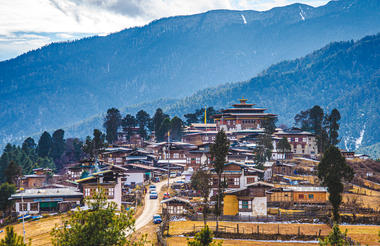
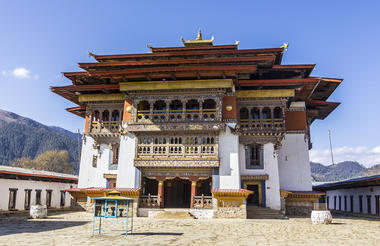
GANGTEY – GANGTEY NATURE WALK
After breakfast at hotel, explore Gangtey (Phobjikha valley) by foot.
Walk to Black Necked Crane Information Centre : Situated on the edge of the forest and wetland along the main road of Phobjikha valley, the black-necked crane information Centre has an observation room equipped with high power telescope and spotting scopes for catching the best view of the cranes. The centre also offers display information that outline the natural and cultural history of the area. There is a small gift shop, which sells handicrafts produced by the local people.
Continue exploring valley, walk to Kilkhorthang located between the upper and lower valleys of Phobjikha and extends from Kilkorthang on the eastern side and crosses the main river to the other side of the valley. This pleasurable walk will give you a pleasant experience. From the small hilltop overlooking Gangtey Goemba, you head downhill through flower meadows to Semchubara village and from here through beautiful forests and into the open valley.
There are several interesting walking trails raging between 1 to 3 hrs, one can chose depending on time availability.
Late evening walk to local family. A leisurely walk through the village will give you rare glimpses into the daily life and lifestyle of the villagers. Bhutanese farm houses are very colorful, decorative and traditionally built without the use of nail. The majority of the population of Bhutan continues to live as it has for centuries – in small isolated farms and hamlets, surrounded by terraced fields of rice, maize and buckwheat.
You will also have an opportunity to try making Suja (traditionally prepared salted butter tea) while at farmer’s home. Buttered tea is usually made by boiling tea leaves, mixed with salted butter and churned using a traditionally made churner.
Overnight at hotel in Gangtey
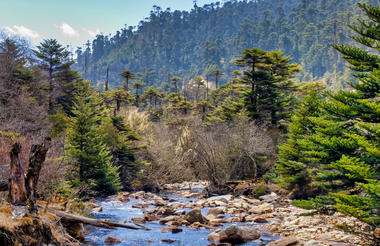

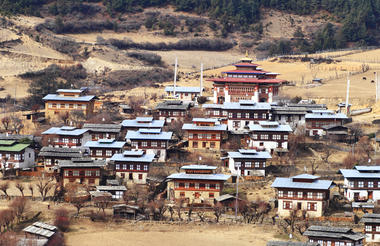
GANGTEY - PUNAKHA (70 KMS, APPROX 5 HRS DRIVE)
After breakfast drive to Punakha passing through dense forests and oak, rhododendron bushes.
After checking into hotel, proceed to visit Punakha Dzong, built strategically at the junction of Pho Chhu and Mo Chhu rivers in 1637, by Shabdrung Ngawang Namgyal to serve as the religious and administrative centre of the region, Punakha Dzong has played an important role in Bhutan's history. Damaged by four catastrophic fires and an earthquake, the Dzong has been fully restored by the present King. The Dzong is open for visitors during Punakha festival and in summer months when the monk body moves to Thimphu.
After a historic moment at the majestic Punakha Dzong, proceed further to visit Richengang village. This is one of the oldest villages in Bhutan with traditional architecture and delightful local people in a remote corner of sleepy Punakha valley, where an ancient way of life has remained unchanged for generations and most of villagers still work at as stonemasons and original craftsmen of dzongs (fort cum monastery) and lhakhans (temples). Walk into a local farmer or stonemason house at Richengang village, peep into the daily life and lifestyle of the villagers. Bhutanese farm houses are very colorful, decorative and traditionally built without the use of nail. The majority of the population of Bhutan continues to live as it has for centuries – in small isolated farms and hamlets, surrounded by terraced fields of rice, maize and buckwheat.
Dinner and overnight at the hotel in Punakha (altitude 1300m/4265ft)



IN AND AROUND PUNAKHA
After breakfast at hotel, proceed for a walking excursion to Chimi Lakhang (from hotel it is about 15 minutes drive till motorable road and then walk starts through paddy fields and villages. This is total about 1.1/2 hour walk, including both way)
The Chimi Lhakhang, situated on a hillock in the centre of the valley, also known as the temple of fertility. It is widely believed that couples who do not have children and wanting one, if they pray at this temple, they are usually blessed with a child very soon. The trail leads across rice fields to the tiny settlement of Pana, meaning ‘field’. A walk through the village near the temple will give you rare glimpses into the daily life and lifestyle of the villagers.
Afternoon hike up through fields of chilies, cabbages to Khamsum Yuelley Namgyal Chorten, which was built to remove negative forces and promote peace, stability and harmony in the changing world. The Chorten dominates the upper Punakha Valley with commanding views across the Mo Chhu and up towards the mountainous peaks of Gasa and beyond.
(approx. less than 2 hrs round trip walk)
If you are not up for another walking excursion, you have option to drive to nunnery:
Take a short drive to the hilltop overlooking vast paddy field and orchard, to Sangchhen Dorji Lhuendrup Lhakhang nunnery:
Perched on a ridge amid pine trees and overlooking valleys of Punakha and Wangduephodrang, gleams the magnificent structures of Sangchhen Dorji Lhuendrup Lhakhang(Temple). The temple houses a 14-foot main bronze statue of Avalokiteshvara (Chenrigzig chagtong chentong). Other statues include those of Guru Padmasambawa, Gautama Buddha, Zhabdrung Ngawang Namgyel, Tsela Namsum, the 21 Taras and Tsepamay (Buddha of longevity). The Avalokiteshvara statue, one of the biggest in the country, was the handiwork of entirely local Bhutanese artisans.
The temple complex also houses a permanent higher learning and meditation centre for nuns where, apart from religious trainings, it provides life skill training such as tailoring, embroidery, statue making and thangka painting.
Dinner and overnight at the hotel in Punakha

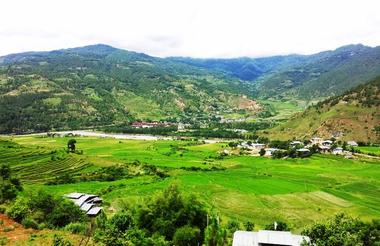

PUNAKHA – PARO (approx. 6 hr drive)
Afterwards drive back to Paro descending back down from Dochu La, follow the way back up the dramatic Wang Chhu and Paro Chhu river valleys, before crossing through Paro Town towards the north end of the valley.
At Dochu La, stop for prayer flag hoisting
Prayer flags are an integral part of Bhutanese landscape and also the cultural and religious heritage of the country, especially the textile and weaving craft. They are ubiquitous in Bhutan; in and around monasteries, chortens or stupas, dzongs, lhakhangs,homes, on the railing of bridges and mountain roads, and invariably on or near the summit of the mighty peaks that preside over the country. Red, blue, green, yellow and white, they add a splash of rainbow colours to the rugged landscape.
Deeply religious, the people of Bhutan believe that with each flutter, a flag releases the prayer printed on it into the air which in turn carries it to the heavens. The more the flag flaps, the greater is its divine value. It is for this reason that prayer flags are positioned that catch the wind – high up on the forested slopes of mountains, across bridges, nearby rivers and streams that tumble down the valleys and anywhere where there is wind and tunnel effect.
Dochula, located at 3000 meter windy hill where intensity of wind is high and is highly revered site for prayer flag hoisting. Flag hoisting is followed by a small tea party at nearby cafeteria enjoying grandest views of Himalayan Range.
Continue drive towards Paro, en route visit Simtokha Dzong, the place of profound tantric teaching, this dzong now houses a school for the study of the Dzongkha language.
Up on arrival at Paro, check into hotel.
The beautiful valley of Paro encapsulates within itself a rich culture, scenic beauty and hundreds of myths and legends. It is home to many of Bhutan's oldest temples and monasteries, National Museum and country's only airport. Mount. Chomolhari (7,314m) reigns in white glory at the northern end of the valley and its glacial water plunge through deep gorges to form Pa Chhu (Paro river). Paro is also one of the most fertile valley in the Kingdom producing a bulk of the locally famous red rice from its terraced fields.
After short rest, proceed to visit Ta Dzong, originally built as Watchtower, which now houses National Museum. The extensive collection includes antique thangkha paintings, textiles, weapons & armour, household objects and a rich assortment of natural and historic artifacts. Ta Dzong visit shortly followed by a short walk down the trail to visit Rinpung Dzong, meaning (“fortress of the heap of jewels”), which has a long and fascinating history. Along the wooden galleries lining the inner courtyard are fine wall paintings illustrating Buddhist lore such as four friends, the old man of long life, the wheel of life, scenes from the life of Milarepa, Mount. Sumeru and other cosmic Mandala.
Dinner and overnight at hotel (altitude 2,280m)
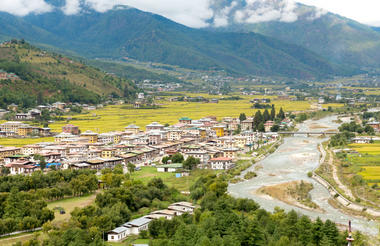
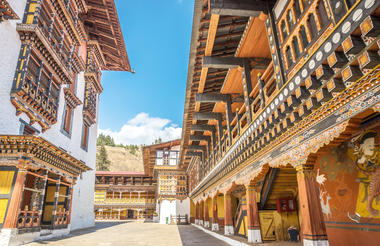
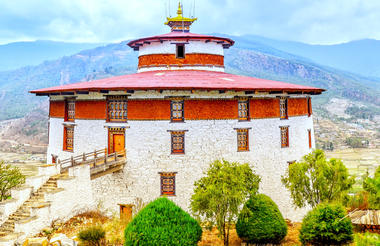
HIKE TO TIGER’S NEST (5 hr round trip walk)
After leisurely breakfast at hotel, board bus to Satsam Chorten, stop en route at the 7th century Kyichu Lhakhang, one of the 108 temples built in the Himalayas by Tibetan King, Songtsen Gampo. The building of this temple marks the introduction of Buddhism in Bhutan.
On arrival at trail-head point, embark on a walking excursion to Taktshang Monastery: It is one of the most famous of Bhutan’s monasteries, perched on the side of a cliff 900m above the Paro valley floor. It is said that Guru Rinpoche arrived here on the back of a tigress and meditated at this monastery and hence it is called ‘Tiger’s Nest’. This site has been recognised as a most sacred place and visited by Shabdrung Ngawang Namgyal in 1646 and now visited by all Bhutanese at least once in their lifetime. On 19 April, 1998, a fire severely damaged the main structure of building but now this Bhutanese jewel has been restored to its original splendour.
Picnick lunch at the base of Tiger’s nest.
In the afternoon, there is free time for relaxation after long hike, self-exploration, walk through tiny Paro market place or drive to nearby Lango village to interact and to photograph Bhutanese rural setting.
Dinner and overnight at hotel.
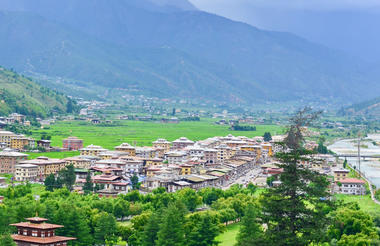
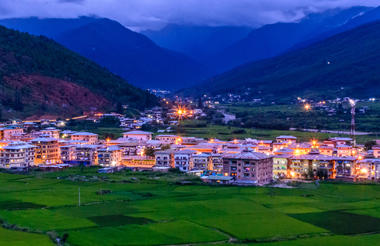
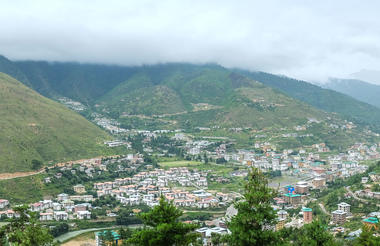
PARO - HIKE AND DOWNHILL BIKE RIDE
After breakfast, proceed for an excursion to Chele La at 3800m. Chele-la that connects Haa to Paro valleys has been one of the important routes in old day for any travelers that would visit Bhutan from Northwestern India. Chele-la harbors one of the most exciting sites for Bhutanese flora. Many species of Primulas, Rhododendron and many more.
About an hour's drive along a thickly-forested road, is this botanical paradise located. The pass provides stunning views of the sacred mountain Jomolhari and Jichu Drake. It is also marked by hundreds of prayer flags fluttering in the wind. Here, visitors can see cascades of wild roses; purple and yellow primulas; and swathes of deep blue iris covering the forest floor. The top of the pass bloom with rhododendrons in a variety of colours-pale pink, deep pink, burnt orange, mauve, white and scarlet.
Walk through the jungle of wild-flowers, following moss and lichen covered ancient trails to Kila Goemba (nunnery) - It is the serene home of Buddhist nuns who have dedicated their life for spiritual fulfillment and leading undisturbed life of religious studies, prayer and meditation. The goemba is nestled in a craggy patch on mountain side below the Chelela pass and perched precariously along the rock face. From Chelela pass, the lhakhang is about an hour walk amidst magnificent wooded area.
Picknick lunch is followed by adrenaline rushing downhill bike ride.
Approx 35 km steep downhill ride from 3800 meter to 22 meter, Paro has one of the most spectacular rides in the country directly overlooking glistening snowy peaks in the eastern range of the great Himalayas including the highest peak of Bhutan, Mt. Jhomolhari 7,230m. Asphalted mountain road snakes through blue pine and rhododendron forests passing through villages, paddy fields, orchards decked in hundred of prayer flags fluttering the wind.
In the late afternoon, transfer to Archery ground where you can experience a short archery session under guidance of a professional archer.
Later in the evening an interaction/talking session with revered monks from the nearby monastery over high tea at hotel (subject to availability & permission by monks)
Dinner and overnight at hotel



Archery is the national sport of Bhutan and every village has its own archery range. Using bamboo bows (although modern compound bows are now common in cities) team of archers shoot at targets only 30 centimeters in diameter from a distance of 120 meters. Each team has a noisy crowd of supporters who, as well as encouraging their own side, try to put off the opposition. Archery competition are among the most picturesque and colorful events in the country and are the integral part of all festivities. Inter-village rivalry is common throughout the Kingdom and this rivalry is no more fiercely expressed than during annual archery tournaments.
After early breakfast at the hotel, drive to the airport for flight to your onward destination. Our representative will help you with exit formalities and then bid you farewell.



